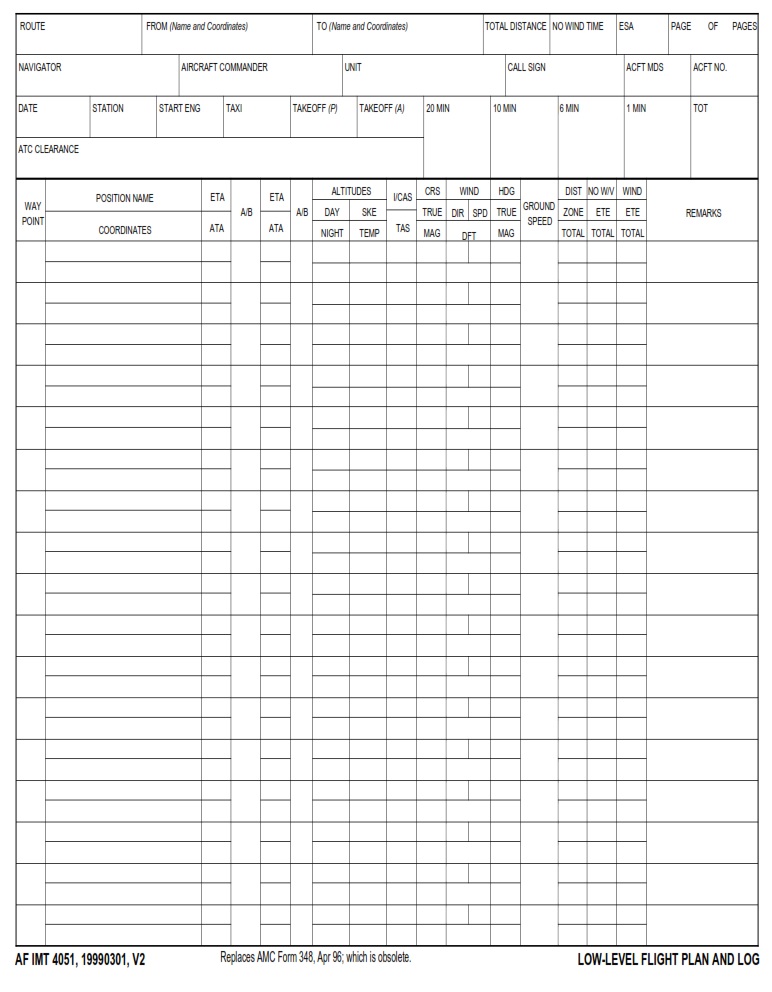AF-FORMS.COM – AF Form 4051 – Low-Level Flight Plan And Log – Have you ever wondered what goes into planning and executing a low-level flight? Picture this: a sleek fighter jet skimming just above the treetops, navigating through rugged terrain with precision and speed. The AF Form 4051 – Low-Level Flight Plan And Log is the essential tool that pilots use to meticulously plan and document these exhilarating missions. In this article, we will delve into the intricate details of this form, exploring how it facilitates the safe and efficient execution of low-level flights while providing an inside look at the adrenaline-pumping world of military aerial maneuvers.
As we unravel the secrets behind the AF Form 4051, prepare to be captivated by the careful calculations, strategic considerations, and sheer skill required for low-level flight operations. From outlining specific route details to accounting for potential hazards and coordinating with ground control, this form serves as a vital companion for pilots venturing into challenging airspace. So buckle up as we take you on a high-flying journey through the fascinating realm of low-level flight planning and logging – where split-second decisions and meticulous preparation can mean the difference between success and disaster in the unforgiving skies.
Download AF Form 4051 – Low-Level Flight Plan And Log
| Form Number | AF Form 4051 |
| Form Title | Low-Level Flight Plan And Log |
| Edition Date | 3/1/1999 |
| File Size | 42 KB |
AF-Form-4051-Low-Level-Flight-Plan-And-Log.pdf (40 downloads )
What is an AF Form 4051?
An AF Form 4051, also known as the Low-Level Flight Plan and Log is a crucial document used by Air Force pilots to record and coordinate low-altitude flight activities. This form serves as a comprehensive planning tool for low-level flights, ensuring the safe execution of training missions and operational flights in controlled airspace. Pilots are required to detail the specific route, altitude, speed, and other essential flight information on the AF Form 4051 before takeoff.
Furthermore, the AF Form 4051 plays a vital role in ensuring safety and compliance with regulations during low-level flying operations. By providing a structured format for documenting flight plans and logging key details during the mission, this form enables effective communication between aircrew members and air traffic control personnel. Not only does it enhance airspace coordination, but it also serves as a valuable resource for debriefing purposes post-flight. The meticulous completion of AF Form 4051 fosters accountability and precision in low-level flight operations while prioritizing safety above all else.
Where Can I Find an AF Form 4051?
If you’re looking for an AF Form 4051, you can typically find it at your local military installation’s operations office or through the base operations support squadron. The form is essential for pilots and aircrew members as it serves as a low-level flight plan and log, documenting critical details such as route information, altitude restrictions, weather conditions, and navigation aids. Additionally, some units may have electronic versions of the form available on their internal network systems or through specialized aviation software.
It’s important to note that accessing the AF Form 4051 may require proper authorization and credentials due to the sensitive nature of flight planning and execution. Therefore, if you’re in need of this form but are not directly involved in aviation operations, it’s best to consult with authorized personnel or request assistance from the appropriate authorities. Understanding the significance of this form underscores its restricted availability and emphasizes the need for responsible handling when obtaining and utilizing it within military environments.
AF Form 4051 – Low-Level Flight Plan And Log
The AF Form 4051, also known as the Low-Level Flight Plan and Log, plays a crucial role in ensuring the safety and effectiveness of low-level flight operations. This form serves as a comprehensive document that details the planned route, altitude, and timing for low-level flights, allowing pilots to adhere to designated airspace boundaries and minimize the risks associated with flying at low altitudes. Furthermore, the form includes provisions for recording vital information such as weather conditions, aircraft performance data, and communication frequencies, providing an essential record of the flight for analysis and review.
One notable feature of AF Form 4051 is its emphasis on thorough pre-flight planning and coordination. By requiring detailed route descriptions and hazard assessments, this form encourages pilots to consider potential obstacles or dangers along their intended flight path. Moreover, the inclusion of clear instructions for in-flight reporting and maneuvering further underscores the importance of precise execution during low-level missions. Overall, this form represents a critical tool in fostering preparedness and vigilance among aircrew members engaged in low-level flight activities.
In conclusion, while it may seem like just another piece of paperwork the AF Form 4051 plays a pivotal role in enhancing aviation safety by promoting meticulous planning and thorough documentation in support of low-level flight operations. Its comprehensive nature speaks volumes about the inherent complexity and challenges involved in conducting flights at lower altitudes while also highlighting the commitment of military aviation personnel to uphold stringent standards for operational excellence.
